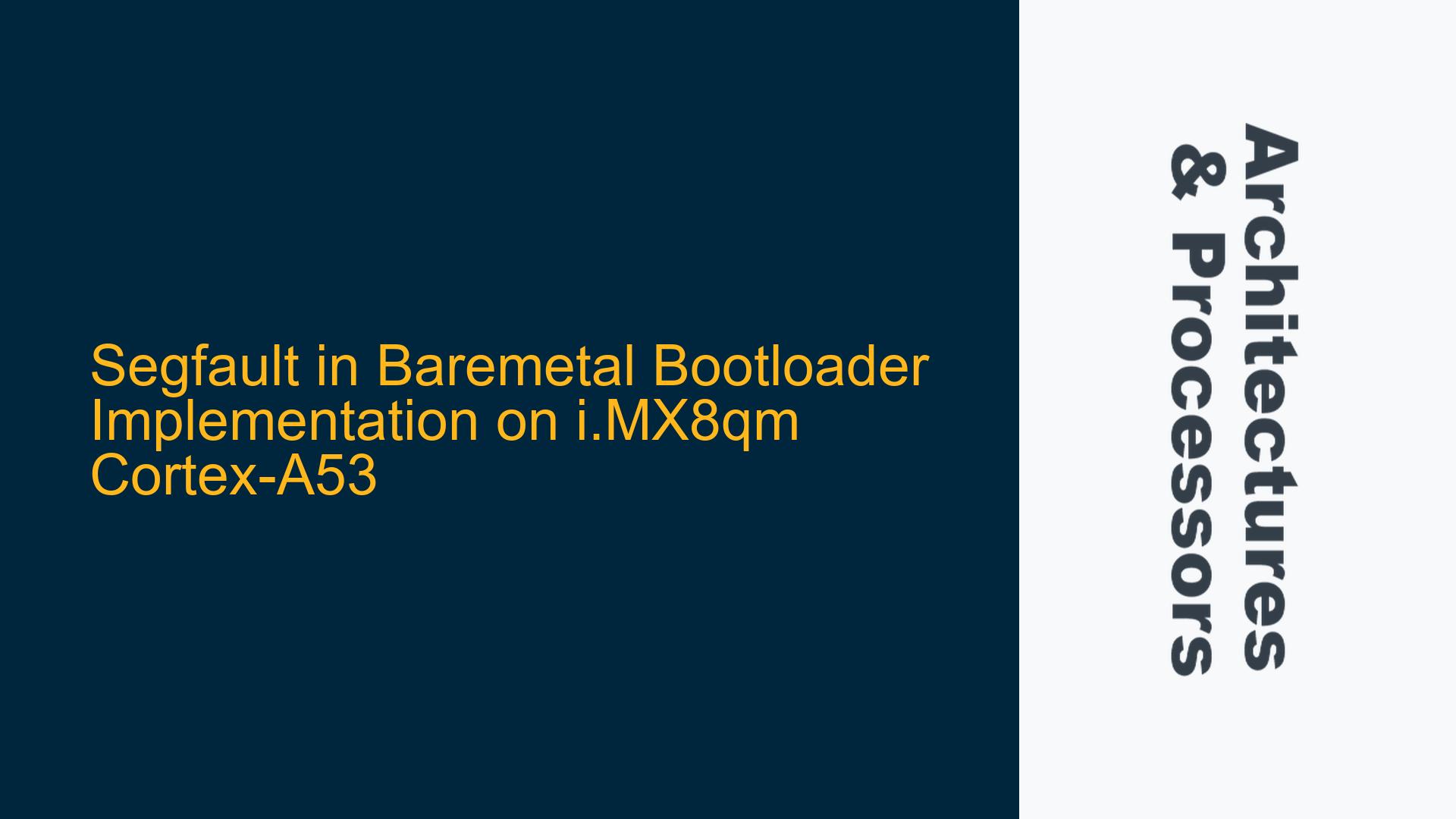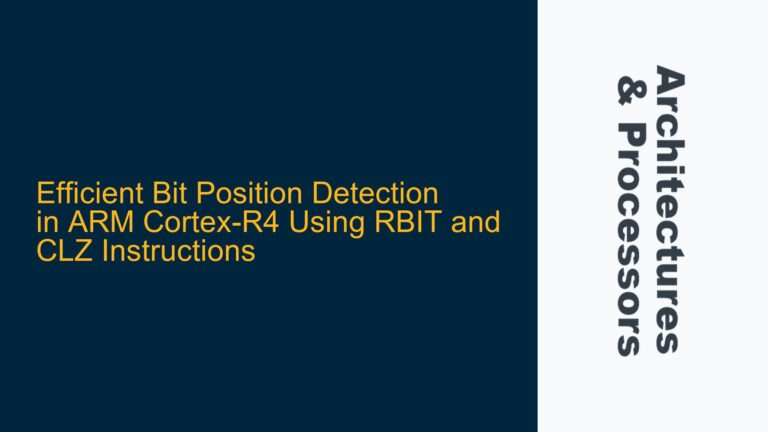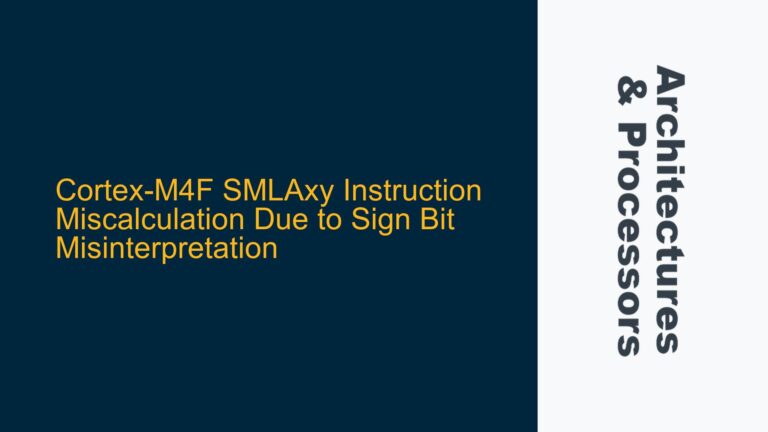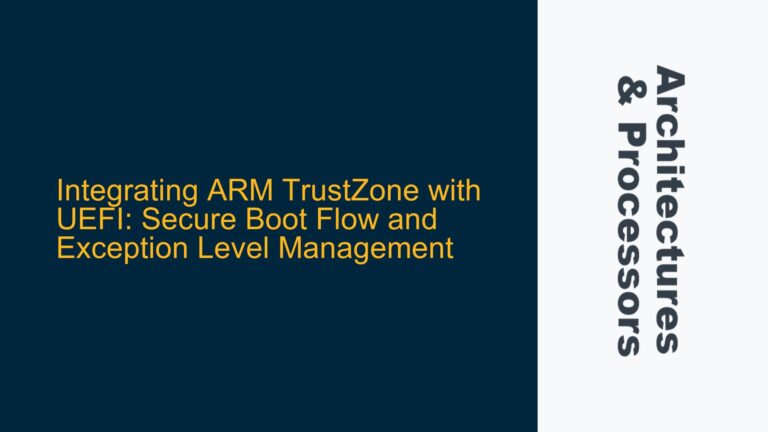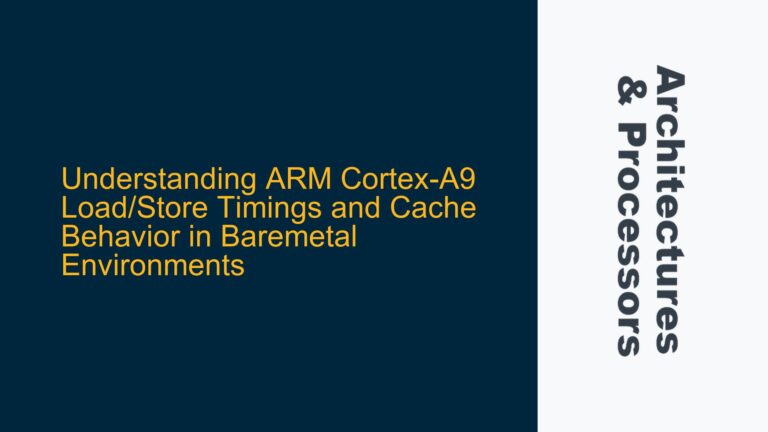ARM Cortex-A53 Bootloader Segfault During Baremetal Initialization
When implementing a baremetal bootloader for the ARM Cortex-A53 processor on the NXP i.MX8qm Evaluation Kit (EVK), a segmentation fault (segfault) can occur during the initialization phase. This issue is particularly common when transitioning from vendor-provided bootloader packages (such as those from NXP’s Yocto BSP) to a minimalistic, custom baremetal implementation. The segfault typically manifests when the bootloader attempts to execute the first instruction of the application or during memory-mapped I/O operations. This problem is often rooted in improper initialization of the ARMv8-A architecture’s execution state, memory management unit (MMU), or exception handling mechanisms.
The ARM Cortex-A53 processor, being part of the ARMv8-A architecture, requires careful setup of its execution environment before any application code can run. This includes configuring the processor’s exception levels (ELs), setting up the MMU or MPU (Memory Protection Unit), and ensuring that the stack pointers and vector tables are correctly initialized. A segfault in this context usually indicates that one or more of these critical initialization steps were either skipped or implemented incorrectly. Additionally, the i.MX8qm’s specific memory map and peripheral initialization requirements must be considered, as improper handling of these can lead to undefined behavior.
Improper Exception Level Transition and MMU Configuration
One of the primary causes of a segfault in a baremetal bootloader implementation on the ARM Cortex-A53 is improper handling of the processor’s exception levels (ELs). The ARMv8-A architecture defines four exception levels (EL0 to EL3), each with its own set of privileges and responsibilities. When the processor boots, it typically starts in EL3 (the highest privilege level) and must transition to the desired exception level (usually EL1 or EL2) before executing application code. Failure to properly configure the Secure Configuration Register (SCR_EL3) or the Hypervisor Configuration Register (HCR_EL2) during this transition can result in a segfault.
Another common cause is incorrect MMU configuration. The MMU is responsible for translating virtual addresses to physical addresses and enforcing memory protection policies. In a baremetal environment, the MMU must be explicitly configured to map the processor’s memory regions correctly. This includes setting up translation tables, enabling the MMU, and ensuring that the memory attributes (such as cacheability and shareability) are correctly defined. If the MMU is not properly configured, the processor may attempt to access unmapped or incorrectly mapped memory regions, leading to a segfault.
Additionally, the i.MX8qm’s memory map and peripheral initialization requirements must be considered. The i.MX8qm has a complex memory map with multiple memory regions, including DDR, OCRAM, and peripheral registers. Each of these regions must be correctly initialized and mapped in the MMU translation tables. Failure to do so can result in the processor attempting to access invalid memory addresses, causing a segfault.
Configuring Exception Levels, MMU, and Memory Map for Stable Bootloader Execution
To resolve the segfault issue in a baremetal bootloader implementation on the ARM Cortex-A53, the following steps should be taken:
Step 1: Properly Configure Exception Levels
The first step is to ensure that the processor transitions correctly from EL3 to the desired exception level (EL1 or EL2). This involves configuring the Secure Configuration Register (SCR_EL3) and the Hypervisor Configuration Register (HCR_EL2) as needed. For example, to transition from EL3 to EL1, the SCR_EL3 register must be configured to disable secure state and enable non-secure state. The following code snippet demonstrates how to configure SCR_EL3 for a transition to EL1:
// Disable secure state and enable non-secure state
MOV X0, #0x1
MSR SCR_EL3, X0
// Set the return address and exception level for ERET
MOV X0, #0x1
MSR SPSR_EL3, X0
ADR X0, el1_entry
MSR ELR_EL3, X0
// Perform the exception return to EL1
ERET
Step 2: Set Up the MMU
The next step is to configure the MMU to correctly map the processor’s memory regions. This involves creating translation tables, enabling the MMU, and defining memory attributes. The following steps outline the process:
- Create Translation Tables: Define the translation tables in memory. Each entry in the table maps a virtual address to a physical address and specifies memory attributes such as cacheability and shareability. For example, to map a 1GB region of DDR memory starting at physical address 0x80000000, the following entry can be used:
// Define the translation table entry
MOV X0, #0x80000000
ORR X0, X0, #0x3 // Set the entry to a block descriptor with read/write permissions
STR X0, [X1, #0] // Store the entry in the translation table
- Enable the MMU: Configure the Translation Table Base Register (TTBR0_EL1) to point to the translation tables and enable the MMU by setting the appropriate bits in the System Control Register (SCTLR_EL1). The following code snippet demonstrates how to enable the MMU:
// Set TTBR0_EL1 to point to the translation tables
MOV X0, #0x8000
MSR TTBR0_EL1, X0
// Enable the MMU by setting the M bit in SCTLR_EL1
MRS X0, SCTLR_EL1
ORR X0, X0, #0x1
MSR SCTLR_EL1, X0
Step 3: Initialize the i.MX8qm Memory Map
Finally, ensure that the i.MX8qm’s memory map is correctly initialized. This includes configuring the DDR controller, initializing the OCRAM, and mapping the peripheral registers in the MMU translation tables. The following steps outline the process:
-
Configure the DDR Controller: The DDR controller must be configured to initialize the DDR memory. This involves setting the appropriate registers in the DDR controller to define the memory size, timing parameters, and other configuration options. Refer to the i.MX8qm reference manual for the specific register settings.
-
Initialize the OCRAM: The OCRAM (On-Chip RAM) must be initialized before it can be used. This involves setting the appropriate registers in the OCRAM controller to enable the memory region and define its size.
-
Map Peripheral Registers: The peripheral registers must be mapped in the MMU translation tables to allow access to the peripherals. This involves creating entries in the translation tables for each peripheral region and defining the appropriate memory attributes.
By following these steps, the segfault issue in the baremetal bootloader implementation on the ARM Cortex-A53 can be resolved, ensuring stable and reliable execution of the bootloader and application code.
